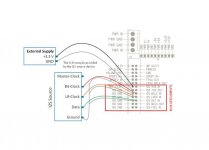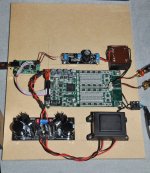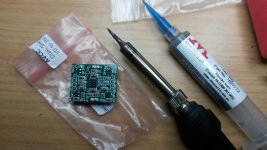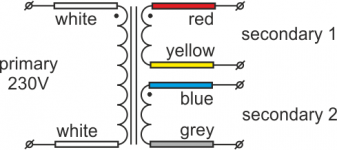Hi all,
a little update ...
The powering of the WaveIO is big progress on spatiality. And the U.FL Cables are on the way to use the non isolated output.
Next step is building the Salas - Shunt Regulator BiB for the DAM powering.
a little update ...
An externally hosted image should be here but it was not working when we last tested it.
The powering of the WaveIO is big progress on spatiality. And the U.FL Cables are on the way to use the non isolated output.
Next step is building the Salas - Shunt Regulator BiB for the DAM powering.
DAM works OK with diyinhk XMOS DSD usb I2S converter?
Yes, perfectly. You only need one dedicated 3.3V supply to feed the converter and the isolator...
Attachments
Yes, perfectly. You only need one dedicated 3.3V supply to feed the converter and the isolator...
So, basicaly, you are feeding 3.3V to XMOS and from XMOS to DAM you connect the same PSU?
Yes, perfectly. You only need one dedicated 3.3V supply to feed the converter and the isolator...
Actually when I used diyinhk xmos board, I didn't provide 3.3v and it's working.
Now I have Amanero which has 3.3v output
Actually when I used diyinhk xmos board, I didn't provide 3.3v and it's working.
Not powering the DAM's "dirty" side has been known to work in some cases, but only for low sampling rates, like 44.1, 48k or even 96k. Above that, the DAM has trouble even locking to the signal.
But I would not recommend it. The I2S signal's quality is probably seriously compromised.
Hi there, it should be fine, my one was......
Going trough all post so far there is one thing that was overlooked and I believe by replacing it could bring performance a notch up (every db is counting ). This is resistor (two to be exact) in low pass filter R625.
As being in direct audio path by replacing it with vishay z-foil equivalent this could bringDAM1021 to a whole different level .
Hi Arf,
About which resistor are you talking ?
Next to the 1.2 nF filter cap I see only 2 resistors of 13 ohm.
Regards,
Danny
Last edited:
Yes, perfectly. You only need one dedicated 3.3V supply to feed the converter and the isolator...
I wouldn't run mains that close to the board,...
//
Basically yes. I am feeding 3.3V to XMOS and from there to the pins of the isolator on the DAM.So, basicaly, you are feeding 3.3V to XMOS and from XMOS to DAM you connect the same PSU?
Thanks for your time. I am collecting all the info I need because in a few days I'll order DAM and XMOS board.
Is DAM volume control good? I saw that it can go to +10dB on 0.99 firmware.
Is DAM volume control good? I saw that it can go to +10dB on 0.99 firmware.
Hi Arf,
About which resistor are you talking ?
Next to the 1.2 nF filter cap I see only 2 resistors of 13 ohm.
Regards,
Danny
Using one vishay naked zfoil in path will not improve anything may be minute since the entire ladder itself is a resistor network path. If all the resistors are upgraded to vishay naked zfoil then the price comes equal to the Total DACs. Total DAC is cheap for what it offers but If all the resistors are replaced with vishay zfoil then sure the dac will be on par with the Total Dac.
What...
I do not understand is (maybe MSB in their sealed modules) why TotalDAC does not have Texas Components make them a custom resistor array on a single foil, or maybe a few single foils? They could still trim everything to super high tolerances, and it has got to be more precise than soldering many leaded resistors to a PCB...
Using one vishay naked zfoil in path will not improve anything may be minute since the entire ladder itself is a resistor network path. If all the resistors are upgraded to vishay naked zfoil then the price comes equal to the Total DACs. Total DAC is cheap for what it offers but If all the resistors are replaced with vishay zfoil then sure the dac will be on par with the Total Dac.
I do not understand is (maybe MSB in their sealed modules) why TotalDAC does not have Texas Components make them a custom resistor array on a single foil, or maybe a few single foils? They could still trim everything to super high tolerances, and it has got to be more precise than soldering many leaded resistors to a PCB...
I do not understand is (maybe MSB in their sealed modules) why TotalDAC does not have Texas Components make them a custom resistor array on a single foil, or maybe a few single foils? They could still trim everything to super high tolerances, and it has got to be more precise than soldering many leaded resistors to a PCB...
Maybe the MOQ for such an array would be 1000 or more though?
The powering of the WaveIO is big progress on spatiality.
Interesting. Not that I wouldn't have expected it.
My JLSounds IF as well as a friends DIYINHK IF behave the same way. Though slightly different.
There are members around here who seriously believe that the USB-I2S interface respectively its implementation can't make a difference, since
the DAM is isolated and reclocked.
It shows again that an isolator and a reclocker are not the final word. (But we know that from other DACs as well)
I would also expect that a Uptone USB-Regen and USB-filters (Jitterbug etc.)
will make a difference. None of the typical USB-I2S interfaces I know can handle the USB mess properly.
Enjoy.
Hi Arf,
About which resistor are you talking ?
Next to the 1.2 nF filter cap I see only 2 resistors of 13 ohm.
Regards,
Danny
Sorry I wasn't more precise, yes those two 13 ohm resistors are part of LPF and in my opinion it would make difference to replace them together with capacitor.
On type of capacitor I am with TNT that Polystyren (not polyester!) caps sound amassing, way better than anything else. Despite Søren assurance that ceramic is OK in that position, go back to his post #143 , where before measuring speed of DAC he got rid of LPF and lifted input pin on LM49710 in order to get 200 ns rise/fall.
I must give him a credit on overall design of DAM1021 dough, it is nice peace of engineering that out of the box (with latest firmware/filters) sound superb.
cheers
Danny
btw can someone enlighten me why pressing Fx (changing filters out of uManager) and enter doesn't echo anything in terminal (at least not in putty) ?
ps could this be good solution for Vref mod? (see attachment)
Attachments
I wouldn't run mains that close to the board,...
Absolutely true TNT.
This is the breadboard for testing, final case layout will be much better and take proper wiring into account.
Still the DAM is as quiet as it can get.
Using one vishay naked zfoil in path will not improve anything may be minute since the entire ladder itself is a resistor network path. If all the resistors are upgraded to vishay naked zfoil then the price comes equal to the Total DACs. Total DAC is cheap for what it offers but If all the resistors are replaced with vishay zfoil then sure the dac will be on par with the Total Dac.
Maybe so, but then again those two resistors (130 marked on them ) are the last RESITORS just before (part of LPF) complete audio signal leave R-2R matrix; so who knows? Using silver solder in audio path definitely doesn't improve low budget audio system but in case of DAM1021 I think every single bit does add up leading to final goal to have best DAC (Søren #161) in the current market (future may tell).
Can we please in this forum be a bit more constructive and not so negative? (Paul left it because XLR ver RCA and other nonsense posts from some members attacking his own believes). After all, this should be DIY fun (with gain/loss who cares) and some people do have more of it than the others.
cheers
Danny
btw even if I had that kind of money to buy TOTAL DAC I know I wouldn't enjoy it this much as I do building it so I bouth DAM1021 not because is "cheap" but because I do believe it is ruff diamond that will SHINE (crazy) soon or later and fun along, PRICELESS (I have already spend more on TP Buffalo III and DAM1021 combine than is sale price of CHORD HUGO).
It shows again that an isolator and a reclocker are not the final word. (But we know that from other DACs as well)
The problem with isolators is that nobody specifies high frequency noise leakage for them. Isolators are intended for galvanic separation, they are not EMI filters. Furthermore, some types of isolators introduce their own noise, which may or may not have a noticeable effect in this application. For example, the Si86xx isolators used in DAM1021 use modulated RF carrier. The datasheet does not specify how much of the carrier signal may be present on the outputs, nor the carrier frequency.
In this respect, I think there may actually be some benefit to using multiple isolators, as long as they attenuate more EMI than they introduce. It may also be beneficial to add lowpass filters on the dirty side of the isolators. Come to think of it, I may actually add some data line EMI filters to the upcoming input board GB. Need to look into it.
The reclocker should be able to handle the additional jitter introduced by limiting I2S signal bandwidth, but it will not do much for jitter caused by EMI.
Common mode noise coming from the isolators may be another problem. Since the isolators are single ended devices, the common mode noise gets coupled directly into the ground plane and pollutes it.
Jitter introduced by the FPGA is probably the limiting factor for DAM1021, but the other jitter sources are still additive and may make a noticeable difference.
This is very interesting as I've always assumed that.Interesting.
There are members around here who seriously believe that the USB-I2S interface respectively its implementation can't make a difference, since
the DAM is isolated and reclocked.
However, after your intervention you made me wanting to try if there is any audible difference in swapping the Amanero I am using now (powered by USB) with another solution I have from an earlier project: a jlsounds I2Sover with oscillator daughter board + crysteks, powered by 3 separate power supplies.
I've always assumed using the JLSounds with first quality oscillators and its own galvanic isolation would be a waste of resources for the DAM, but now I am curious. I'll test and report.
Thanks for your time. I am collecting all the info I need because in a few days I'll order DAM and XMOS board.
Is DAM volume control good? I saw that it can go to +10dB on 0.99 firmware.
Yes it is excellent after all bugs in volume control that we know off so far are fixed in 0.99 firmware, however, personally I am not using it (have wyred4sound STP-SE pre) and wish
that there is optional firmware where this doesn't exist and these bits are used for longer taps in FR. Get yourself unbuffered XMOS board (cheaper option), as DAM1021 already have I2S buffer. And on power I would (as I did ) suggest you to order one 6-7v AC dual winding 30VA toroid (if using RAW out-if not for buffered I would go with 2x9VAC), and you are set. I know 30VA is overkill but there is reason to have oversized trafo and small filter caps. Also keep in mind that there is, even with latest boards slight "tump" if connected direct to power amp so observe power up/down routine.
good luck
cheers
Danny
Attachments
- Home
- Vendor's Bazaar
- Reference DAC Module - Discrete R-2R Sign Magnitude 24 bit 384 KHz



